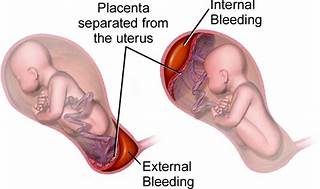A nurse is reinforcing teaching with a newly licensed nurse about the complications associated with maternal gestational diabetes. Which of the following complications should the nurse include?
Placenta previa.
Newborn hypoglycemia.
Small for gestational age newborn.
Oligohydramnios.
The Correct Answer is B
Choice B rationale:
The correct answer is Choice B, which is "Newborn hypoglycemia.”. Newborn hypoglycemia is a potential complication associated with maternal gestational diabetes. When a pregnant woman has gestational diabetes, her blood glucose levels can be elevated, leading to increased insulin production in the fetus. After birth, the baby's insulin production continues at a high level, which can result in a rapid drop in blood glucose levels, causing hypoglycemia. This condition can be serious and requires close monitoring and timely intervention to prevent complications in the newborn.
Choice A rationale :
Placenta previa is not a complication associated with maternal gestational diabetes. Placenta previa occurs when the placenta partially or completely covers the cervix, which can lead to bleeding during pregnancy and delivery. However, this condition is not directly related to gestational diabetes, and there is no physiological rationale connecting the two.
Choice C rationale
Small for gestational age (SGA) newborn is not a direct complication of maternal gestational diabetes. SGA refers to babies who are smaller in size than expected for their gestational age. While poorly controlled diabetes during pregnancy can lead to large babies (macrosomia), it is not typically associated with small babies.
Choice D rationale
Oligohydramnios, which is a condition characterized by low levels of amniotic fluid, is not a common complication associated with maternal gestational diabetes. Oligohydramnios can be caused by various factors, but it is not specifically linked to gestational diabetes.
Nursing Test Bank
Naxlex Comprehensive Predictor Exams
Related Questions
Correct Answer is A
Explanation

The correct answer is choice A, Maternal hypertension.
Choice A rationale:
Maternal hypertension is widely recognized as the most common risk factor for placental abruption. High blood pressure can cause the placenta to detach from the uterine wall, leading to abruption. In summary, while all the listed factors can contribute to the risk of placental abruption, maternal hypertension stands out as the most common cause, supported by multiple health sources. It’s important for nurses to recognize and manage hypertension in pregnant clients to minimize the risk of this serious complication.
Choice B rationale:
While maternal cocaine use is a significant risk factor for placental abruption due to its vasoconstrictive effects, which can compromise the placental blood flow, it is not as common as maternal hypertension.
Choice C rationale:
Maternal cigarette smoking is also a risk factor for placental abruption. Smoking can lead to a variety of complications in pregnancy, including placental problems, but again, it is less common than hypertension as a cause for abruption.
Choice D rationale:
Maternal battering can lead to trauma which may result in placental abruption. However, it is not considered the most common risk factor when compared to maternal hypertension.
Correct Answer is A
Explanation
Choice A rationale:
Supporting the infant during birth. The priority for the nurse in this situation is to ensure the safe delivery of the baby. By supporting the infant during birth, the nurse can help ensure that the baby is delivered safely and efficiently. This involves assisting the mother in pushing and guiding the baby's head and body as it emerges from the birth canal. The nurse should also be ready to catch the baby and provide immediate care, such as drying and stimulating the baby to breathe if necessary.
Choice B rationale
Preventing the perineum from tearing. While preventing perineal tearing is important, it is not the top priority in this rapidly progressing labor scenario. The immediate concern is the safe delivery of the baby, and if perineal tearing does occur, it can be addressed after the birth.
Choice C rationale
Cutting the umbilical cord. This action is necessary but not the top priority. After the baby is delivered, the nurse should clamp and cut the umbilical cord to separate the baby from the placenta. However, this can wait until the baby is fully delivered and breathing on their own.
Choice D rationale
Promoting delivery of the placenta. Again, while delivering the placenta is important to prevent postpartum haemorrhage, it is not the priority in this scenario. The nurse's immediate focus should be on supporting the infant's delivery and ensuring the baby's well-being.
Whether you are a student looking to ace your exams or a practicing nurse seeking to enhance your expertise , our nursing education contents will empower you with the confidence and competence to make a difference in the lives of patients and become a respected leader in the healthcare field.
Visit Naxlex, invest in your future and unlock endless possibilities with our unparalleled nursing education contents today
Report Wrong Answer on the Current Question
Do you disagree with the answer? If yes, what is your expected answer? Explain.
Kindly be descriptive with the issue you are facing.
